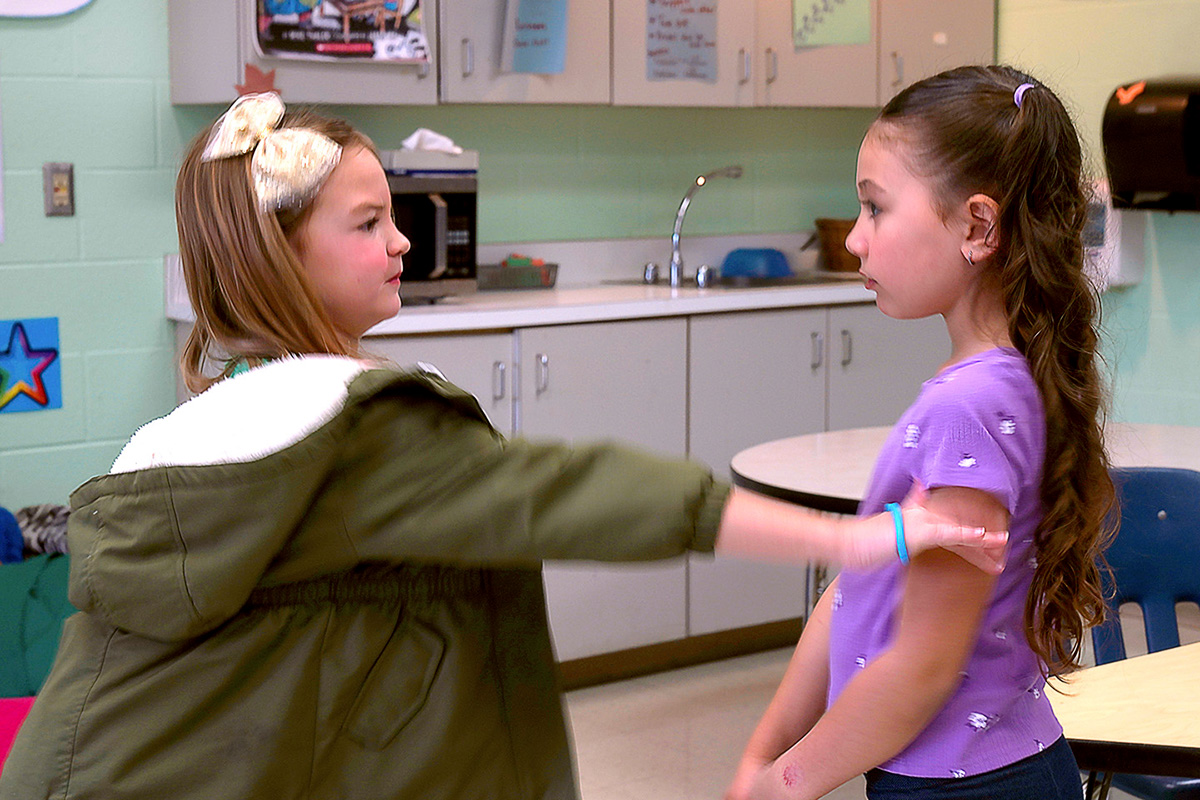How can educators modify a student’s behavior?
Page 2: Addressing the Function of a Behavior
 It is critical that the interventions included in a BIP address the underlying purpose, or function, of an interfering behavior. Therefore, BIP teams must rely on the hypothesis statement generated by the FBA to drive their intervention planning. The hypothesis statement outlines the pattern of antecedents and consequences that are relevant to a student’s target behavior and suggests the likely function of the behavior. The following table describes the four primary functions of behavior.
It is critical that the interventions included in a BIP address the underlying purpose, or function, of an interfering behavior. Therefore, BIP teams must rely on the hypothesis statement generated by the FBA to drive their intervention planning. The hypothesis statement outlines the pattern of antecedents and consequences that are relevant to a student’s target behavior and suggests the likely function of the behavior. The following table describes the four primary functions of behavior.
antecedent
DEFINITION_DEFINITION_DEFINITION_DEFINITION
consequence
DEFINITION_DEFINITION_DEFINITION_DEFINITION
| Function | Description |
| Attention | The student seeks social interactions, recognition, or assistance from others. Even negative attention from peers or educators (e.g., teacher reprimands, peer reactions) can reinforce a student’s behavior. |
| Items or activities | The student seeks access to tangible items (e.g., stickers, school supplies) or intangible activities (e.g., being first in line, using technology, playing a game). |
| Escape | The student seeks to change, stop, or take a break from a difficult or unpleasant experience. In the classroom, this might include escaping from challenging academic work, sensory environments, or social interactions. |
| Automatic |
The student engages in behaviors that produce internal sensations, such as sensory stimulation, relief from discomfort, or reduction of anxiety. And these behaviors are referred to as self-stimulatory, taking the form of self-injury, thumb-sucking, rocking, and hand flapping, to name a few. Note: Automatic functions are very rare. Because there are complex ethical considerations for attempting to change self-stimulatory behavior, educators should always consult with other relevant professionals (e.g., behavior analysts, occupational therapists) if this function is suspected. Consequently, automatic functions will not be addressed in this module. x
behavior analyst DEFINITION_DEFINITION_DEFINITION_DEFINITION x
occupational therapist (OT) DEFINITION_DEFINITION_DEFINITION_DEFINITION |
The interventions that comprise a BIP should be carefully designed to address the hypothesized function of the target behavior by teaching and reinforcing a more acceptable behavior the student can engage in to get their needs met. Such interventions are known as function-based interventions. They leverage an understanding of the “why” behind a student’s behavior to better address the behavior’s root cause, not just its symptoms. For example, if a student yells and curses to access teacher attention, a function-based intervention would involve teaching and reinforcing a more appropriate way to request interaction or assistance, like raising a hand or using a hand signal.
Caution: When educators respond to a behavior without understanding its function, their efforts will likely be ineffective. Imagine a student who engages in property destruction (e.g., ripping paper, breaking pencils, throwing materials). Assuming that the behavior is attention seeking, the teacher decides to ignore it and instead praise the student when they appropriately engage with materials. However, if the true function of the property destruction is to escape from difficult academic work, ignoring it would not address the student’s underlying need and could inadvertently reinforce the interfering behavior, potentially making it worse.
Research Shows
A review of 24 studies comparing function-based and non-function-based interventions revealed:
- Function-based interventions were more effective in reducing a variety of interfering behaviors, including aggressive, disruptive, and non-compliant behavior.
- These findings held true for students of all ages with and without disabilities.
- Teachers reported that function-based interventions were just as easy to use as other interventions, but they worked better for students.
Jeong & Copeland, 2020
The most effective BIPs are made up of function-based interventions that are tailored to a student’s unique needs. In this interview, Johanna Staubitz describes how teams can use the information from an FBA to develop a plan that respects a student’s dignity and addresses their underlying needs.

Johanna Staubitz, PhD, BCBA-D
Assistant Professor
Department of Special Education
Vanderbilt University
Transcript: Johanna Staubitz, PhD, BCBA-D
TBA
In this interview, Bettie Ray Butler discusses the benefits of function-based interventions (time: 2:21).

Bettie Ray Butler, PhD
Professor of Urban Education
University of North Carolina at Charlotte
Transcript: Bettie Ray Butler, PhD
The benefits that come from having function-based interventions in place is that it enhances learning for that individual student, which will increase engagement and participation in the learning process. It’s seeing the student in their humanness. Giving the student the benefit of the doubt that with the proper intervention, that whatever behaviors have presented themselves that appear to be challenging, they can be replaced with behaviors that acclimate them to a learning environment and increase their opportunities to learn.
The focus is placed on the behavior and not necessarily the student. It is individualized because no two students are the same. They may present the same behavior, but they are not the same person. And what causes the behavior for one student may be very different than what causes the behavior for another student.
Also, it reduces the risk of punitive forms of punishment. There’s oftentimes what we call “zero tolerance policies,” where behaviors appear and the immediate response without understanding the function of that behavior is to exclude those students from the learning environment. I’ve heard teachers talk about this from the perspective of “It’s the greater good. It’s okay to remove one student that has challenging behaviors because we’re trying to preserve the learning environment for the rest of the students.” But unfortunately, if we’re looking at this through a culturally responsive lens, the exclusion of one student is never good and it is never to the benefit of the larger group, especially when the exclusion then subsequently necessitates punitive forms of punishment, for example, out-of-school suspension or expulsion.
But the function-based interventions, it acts as this intervening factor that could potentially disrupt exclusion from the learning environment for students who are having challenges in the classroom space.
Returning to the Challenge (Elementary)
Recall that DJ and Presley both display interfering behaviors and that their teams conducted FBAs to better understand their needs. This process resulted in the following hypothesis statements.
 DJ: During whole-group instruction or independent work, when the teacher is addressing the class, DJ engages in verbal or non-verbal activities that are unrelated to instruction or the assigned task. This results in verbal redirections from the teacher and verbal or non-verbal responses from peers. DJ’s team hypothesized that he engages in unrelated activities to access adult and peer attention.
DJ: During whole-group instruction or independent work, when the teacher is addressing the class, DJ engages in verbal or non-verbal activities that are unrelated to instruction or the assigned task. This results in verbal redirections from the teacher and verbal or non-verbal responses from peers. DJ’s team hypothesized that he engages in unrelated activities to access adult and peer attention.
 Presley: During social interactions or unstructured time, when a peer enters Presley’s personal space or attempts to engage in a social interaction, Presley initiates forceful physical contact with another person’s body. This results in the peer stopping the interaction by moving away. Presley’s team hypothesized that she initiates physical contact to escape peer interactions. This is more likely to occur when Presley has just returned to school from a break.
Presley: During social interactions or unstructured time, when a peer enters Presley’s personal space or attempts to engage in a social interaction, Presley initiates forceful physical contact with another person’s body. This results in the peer stopping the interaction by moving away. Presley’s team hypothesized that she initiates physical contact to escape peer interactions. This is more likely to occur when Presley has just returned to school from a break.
At this point, DJ’s and Presley’s teams are ready to begin developing BIPs to address their behavior. The hypothesis statements will be critical in guiding the creation, implementation, monitoring, and adjustment of the students’ BIPs.